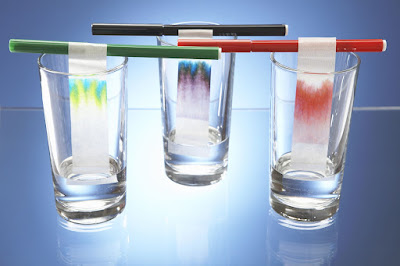Microfluidic Revolution: The Future of Medicine is Miniaturized
Microfluidic refers to the behavior,
precise control and manipulation of fluids that are geometrically constrained
to a small, typically sub-millimeter, scale. Microfluidic technologies involve
creating complex fluidic networks on miniaturized chips that allow the
integrated performance of multiple functions on millimeter or even micrometer
length scales. Advances in Microfluidic hold immense promise to revolutionize
various industries like healthcare, chemistry, environmental monitoring and
more.
What is Microfluidic?
As the name suggests, Microfluidic
deals with handling minute volumes of fluids, typically in the range of
microliters to picoliters, using microfabricated devices called microfluidic
chips or lab-on-a-chip devices. The key characteristic of Microfluidic is that
at least one dimension of the system is between 0.1 to 1000 micrometers which
causes fluids to behave quite differently than at the macro scale due to
dominance of surface tension and various fluidic phenomena. The core principles
of fluid dynamics still apply but additional effects like laminar flow and
fluid diffusion come into play at the microscale.
Microfluidic chips are engineered using techniques of microfabrication from
microelectronics combined with glass or polymer moulding. They integrate
multiple fluidic components like pumps, valves, channels, wells, reaction
chambers etc. onto a single miniaturized platform. These allow automated fluid
manipulation and processing of very small fluid samples, often in the range of
nanoliters to picoliters. They offer enhanced control, reproducibility and
integration of complex fluidic operations.
Applications and Advances in Microfluidic
Microfluidic finds applications across various areas due to its precise control
over minute volumes of fluids:
- Healthcare diagnostics: Microfluidic lab-on-a-chip devices offer rapid,
portable and low-cost diagnostics platforms for disease testing. This includes
point-of-care disease diagnosis from minute blood or urine samples. Companies
are developing microfluidic tests for cancers, infectious diseases, cardiac
conditions etc.
- Drug discovery and screening: Microfluidic chips enable high-throughput
screening of thousands of drug molecules simultaneously in nanoliter reaction
volumes. This speeds up drug discovery process and lowers associated costs considerably.
- Biomedical research: Microfluidic is aiding research in tissue engineering,
cell culturing, organ-on-a-chip models and studying basic cell biology
processes occurring at the microscale.
- environmental monitoring: Minaturized sensors integrated with microfluidic
systems detect pollutants in air and water at trace levels for applications in
pollution monitoring.
- chemistry: Microreaction and continuous flow chemistry leverages Microfluidic
for performing complex chemical and biochemical syntheses in microreactors.
Recent advances have further enhanced capabilities of microfluidic systems:
- 3D printing of microfluidic chips: Enables rapid printing of customizable
fluidic circuits and components without cleanroom facilities lowering costs.
- Paper-based Microfluidic: Creation of simple and inexpensive paper or fabric
based diagnostic chips that can wick fluids via capillary action for
applications in resource-limited settings.
- Digital Microfluidic: Precise manipulation of nanoliter droplet volumes via
electrowetting on dielectric (EWOD) surface for applications like
high-throughput screening, single-cell analysis etc.
- Organs-on-chips: Sophisticated human organ mimic microfluidic chips
containing living cells in a structured microenvironment are creating in vitro
microphysiological models of human organs.
- Point-of-care diagnostic devices: Fully portable and miniaturized diagnostic
systems integrated with microfluidic sample processing and readout mechanisms
are bridging gap between centralized clinical labs and field testing
capabilities.
Microfluidic has steadily progressed from proof-of-concept research to
commercial products over last two decades. It is estimated that the global Microfluidic
market was valued at over $8 billion in 2020 and projected to grow further
driven by increasing demand across various industries especially healthcare.
Microfluidic devices and systems hold immense potential to transform medicine,
chemistry, biotechnology and more through miniaturization and system
integration of complex fluidic functionalities.
The Future of Microfluidic
As microfabrication techniques and materials advance further, microfluidic
systems are expected to gain even greater functional complexity mimicking human
physiologies at the organ and whole body levels. Some promising areas where Microfluidic
is envisioned to make significant impact in the near future include:
- Personalized medicine - Microfluidic diagnostics and drug testing will enable
precision medicine tailored for individual patient needs. “Liquid biopsies”
from disease-on-a-chip microfluidic models will aid in non-invasive disease
monitoring and timely therapeutic interventions.
- Point-of-care diagnostics - Completely portable and easy-to-use microfluidic
diagnostics chips integrated with smartphone readout will revolutionize
ubiquitous healthcare by bringing lab-quality testing to anywhere, anytime.
This will be game changing especially for pandemic responses and in
resource-scarce locations.
- Organ replacements - Advancing towards assembling functional human organ
mimicking microfluidic systems from organ-specific cell populations, materials
and fluidic perfusion networks may one day create artificial pancreases,
livers, lungs and even complete organ replacements grown outside the body.
- Microfactories - Miniaturized continuous flow microreactors may serve as
automated “microfactories” perfused with biochemical reagents to mass
manufacture medications, diagnostics and complex specialty chemicals in a sustainable
clean format with precise control.
- Microbiome studies - Microfluidic chips that can culture complex communities
of human gut microbes, protozoa and their interactions under controlled
conditions at minute scales opens up microbiome research avenues with
applications in health, nutrition and beyond.
With the advantages of precision, efficiency, low sample/reagent consumption
and system integration, microfluidic technologies are expected to spearhead a
new era of personalized intelligent healthcare. Combined with rapid advances in
materials, microfabrication, 3D printing and artificial intelligence, Microfluidic
holds great promise to transform industries and build a healthier future.
Get More Insights on this Topic https://www.trendingwebwire.com/mastering-microfluidic-small-scale-solutions-for-big-impact/




Comments
Post a Comment